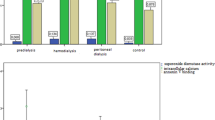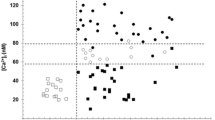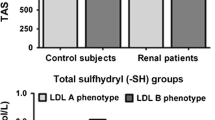Abstract
It has been suggested that oxidative stress may participate in the progression of diabetes and its complications. Long-term complications of type 2 diabetes mellitus (T2DM) include retinopathy, atherosclerosis, shortened life span of erythrocytes, nephropathy, and chronic kidney disease (CKD). Oxidative damage has been associated with erythrocyte apoptosis induction in other pathological conditions. Our aim was to study the presence of eryptosis and its possible relationship with oxidative damage in patients with T2DM without CKD (T2DM/CKD(−)) and in patients with T2DM and CKD (T2DM/CKD(+)).Oxidative damage of lipids erythrocytes were increased in diabetic patients. The highest lipoperoxidation was found in T2DM/CKD(+). Likewise, the lower plasma total antioxidant capacity, GSH/GSSG ratio, and GSH in erythrocytes were found in T2DM/CKD(+) patients. A negative correlation was found between plasma total antioxidant capacity and oxidative damage. Phosphatidylserine (PS) externalization was measured in erythrocytes to evaluate eryptosis. Annexin binding in erythrocytes of T2DM/CKD(+) patients was higher than in healthy subjects and T2DM/CKD(−) patients. A positive correlation between lipoperoxidation and PS externalization in erythrocytes was found. This work showed that the erythrocytes of diabetic patients have increased oxidative damage, a reduction of antioxidant systems and more erythrocyte PS externalization. The duration of diabetes and the presence of CKD increase both oxidative damage and eryptosis. It is possible that a longer time of evolution induces an increase in erythrocyte oxidative damage and the consumption of blood antioxidant systems, adding to the osmotic stress in CKD and so contributes to an increase in PS externalization in diabetic patients.






Similar content being viewed by others
References
IDF (2009) Diabetes Atlas at the 20th World Diabetes Congress in October 2009, Montreal, Canada. http://www.diabetesatlas.org/. Accessed February, 2011
Golbidi S, Ebadi SA, Laher I (2011) Antioxidants in the treatment of diabetes. Curr Diabetes Rev 7(2):106–125
American Diabetes Association (2007) Diagnosis and classification of diabetes mellitus. Diabetes Care, http://care.diabetesjournals.org/content/30/suppl_1/S42.full. Accessed February, 2011
Kaneto H, Katakami N, Matsuhisa M, Matsuoka TA (2010) Role of reactive oxygen species in the progression of type 2 diabetes and atherosclerosis. Mediat Inflamm 2010:453892
Takayanagi R, Inoguchi T, Ohnaka K (2011) Clinical and experimental evidence for oxidative stress as an exacerbating factor of diabetes mellitus. J Clin Biochem Nutr 48(1):72–77
Likidlilid A, Patchanans N, Peerapatdit T, Sriratanasathavorn C (2010) Lipid peroxidation and antioxidant enzyme activities in erythrocytes of type 2 diabetic patients. J Med Assoc Thai 93(6):682–693
Mahboob M, Rahman MF, Grover P (2005) Serum lipid peroxidation and antioxidant enzyme levels in male and female diabetic patients. Singap Med J 46(7):322–324
Srivatsan R, Das S, Gadde R, Manoj-Kumar K, Taduri S, Rao N, Ramesh B, Baharani A, Shah K, Kamireddy SC, Priyatham G, Balakumaran TA, Balakumaran SS, Kamath A, Rao A (2009) Antioxidants and lipid peroxidation status in diabetic patients with and without complications. Arch Iran Med 12(2):121–127
Jain SK, McVie R, Duett J, Herbst JJ (1989) Erythrocyte membrane lipid peroxidation and glycosylated hemoglobin in diabetes. Diabetes 38(12):1539–1543
Giacco F, Brownlee M (2010) Oxidative stress and diabetic complications. Circ Res 107(9):1058–1070
Singh DK, Winocour P, Farrington K (2011) Oxidative stress in early diabetic nephropathy: fueling the fire. Nat Rev Endocrinol 7(3):176–184
Lam CS, Benzie IF, Choi SW, Chan LY, Yeung VT, Woo GC (2011) Relationships among diabetic retinopathy, antioxidants, and glycemic control. Optom Vis Sci 88(2):251–256
Tsutsui H, Kinugawa S, Matsushima S, Yokota T (2011) Oxidative stress in cardiac and skeletal muscle dysfunction associated with diabetes mellitus. J Clin Biochem Nutr 48(1):68–71
Wagener FAD, Dekker D, Berde JH, Sharstuhl A, Van der Vlag J (2009) The role of reactive oxygen species in apoptosis in the diabetic kidney. Apoptosis 14:1451–1458
Shah SV, Baliga R, Rajapurka M, Fonseca VA (2007) Oxidants in chronic kidney disease. J Am Soc Nephrol 18:16–28
Puchades Montesa MJ, González Rico MA, Solís Salguero MA, Torregrosa Maicas I, Tormos Muñoz MC, Saez Tormo G, Juan Garcia I, Miguel Carrasco A (2009) Study of oxidative stress in advanced kidney disease. Nefrologia 29(5):464–473
Hur J, Sullivan KA, Schuyler AD, Hong Y, Pande M, States DJ, Jagadish HV, Feldman EL (2010) Literature-based discovery of diabetes- and ROS-related targets. BMC Med Genomics 3:49
Zitouni K, Nourooz-Zadeh J, Harry D, Kerry SM, Betteridge DJ, Cappuccio FP, Earle KA (2005) Race-specific differences in antioxidant enzyme activity in patients with type 2 diabetes: a potential association with the risk of developing nephropathy. Diabetes Care 28(7):1698–1703
Beisswenger PJ, Drummond KS, Nelson RG, Howell SK, Szwergold BS, Mauer M (2005) Susceptibility to diabetic nephropathy is related to dicarbonyl and oxidative stress. Diabetes 54(11):3274–3281
Nicolay JP, Schneider J, Niemoeller OM, Artunc F, Portero-Otin M, Haik G Jr, Thornalley PJ, Schleicher E, Wieder T, Lang F (2006) Stimulation of suicidal erythrocyte death by methylglyoxal. Cell Physiol Biochem 18(4–5):223–232
Pavone B, Bucci S, Sirolli V, Merlini G, Del Boccio P, Di Rienzo M, Felaco P, Amoroso L, Sacchetta P, Di Ilio C, Federici G, Urbani A, Bonomini M (2011) Beta2-microglobulin causes abnormal phosphatidylserine exposure in human red blood cells. Mol Biosyst 7(3):651–658
Bonomini M, Sirolli V, Settefrati N, Dottori S, Di Liberato L, Arduini A (1999) Increased erythrocyte phosphatidylserine exposure in chronic renal failure. J Am Soc Nephrol 10(9):1982–1990
KDOQI (2007) Diabetes and chronic kidney disease. Guidelines. Guidelines for CKD Care. http://www.kidney.org/professionals/kdoqi/guideline_diabetes/guide2.htm. Accessed February, 2011
Kambayashi Y, Binh NT, Asakura HW, Hibino Y, Hitomi Y, Nakamura H, Ogino K (2009) Efficient assay for total antioxidant capacity in human plasma using a 96-well microplate. J Clin Biochem Nutr 44(1):46–51
Quintanar-Escorza MA, González-Martínez MT, Intriago-Ortega MP, Calderón-Salinas JV (2010) Oxidative damage increases intracellular free calcium [Ca2+]i concentration in human erythrocytes incubated with lead. Toxicol In Vitro 24(5):1338–1346
Tait JF, Gibson D (1992) Phospholipid binding of annexin V: effects of calcium and membrane phosphatidylserine content. Arch Biochem Biophys 298:187–191
Reynoso R, Salgado LM, Calderón V (2003) High levels of palmitic acid lead to insulin resistance due to changes in the level of phosphorylation of the insulin receptor and insulin receptor substrate-1. Mol Cell Biochem 46(1–2):155–162
Arreola-Mendoza L, Del Razo LM, Mendoza-Garrido ME, Martin D, Namorado MC, Calderon-Salinas JV, Reyes JL (2009) The protective effect of alpha-tocopherol against dichromate-induced renal tight junction damage is mediated via ERK1/2. Toxicol Lett 191(2–3):279–288
Cervantes-Cervantes MP, Calderon-Salinas JV, Albores A, Muñoz-Sanchez JL (2005) Cooper increases the damage to DNA and proteins caused by reactive oxygen species. Biol Trace Elem Res 103(3):229–248
Lang PA, Kempe DS, Myssina S, Tanneur V, Birka C, Laufer S, Lang F, Wieder T, Huber SM (2005) PGE2 in the regulation of programmed erythrocyte death. Cell Death Differ 12:415–428
Lang F, Gulbins E, Lang PA, Zappulla D, Föller M (2010) Ceramide in suicidal death of erythrocytes. Cell Physiol Biochem 26(1):21–28
Banerjee T, Kuypers FA (2004) Reactive oxygen species and phosphatidylserine externalization in murine sickle red cells. Br J Haematol 124(3):391–402
Solá E, Vayá A, Martínez M, Moscardó A, Corella D, Santaolaria ML, España F, Hernández-Mijares A (2009) Erythrocyte membrane phosphatidylserine exposure in obesity. Obesity 17(2):318–322
Föller M, Bobbala D, Koka S, Huber SM, Gulbins E, Lang F (2009) Suicide for survival death of infected erythrocytes as a host mechanism to survive malaria. Cell Physiol Biochem 24(3–4):133–140
Festa A, D’Agonstino R, Howard G, Mykkanen L, Tracy R, Haffner S (2000) Inflammation and microalbuminuria in nondiabetic and type 2 diabetic subjects: the Insulin Resistance Atherosclerosis Study. Kidney Int 58:1703–1710
Lang KS, Lang PA, Bauer C, Duranton C, Wieder T, Huber SM, Lang F (2005) Mechanisms of suicidal erythrocyte death. Cell Physiol Biochem 15(5):195–202
Acknowledgments
The authors thank M. Rosas-Flores for technical assistance. This work was partially supported by CONACyT fellowship FOMIX grants DGO-2007-C01-66692.
Author information
Authors and Affiliations
Corresponding author
Rights and permissions
About this article
Cite this article
Calderón-Salinas, J.V., Muñoz-Reyes, E.G., Guerrero-Romero, J.F. et al. Eryptosis and oxidative damage in type 2 diabetic mellitus patients with chronic kidney disease. Mol Cell Biochem 357, 171–179 (2011). https://doi.org/10.1007/s11010-011-0887-1
Received:
Accepted:
Published:
Issue Date:
DOI: https://doi.org/10.1007/s11010-011-0887-1




